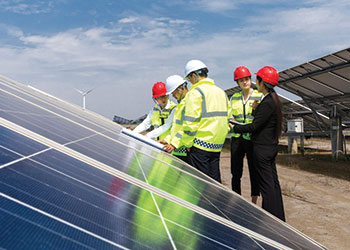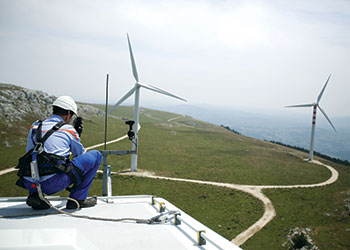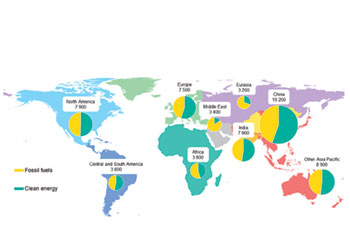
 Several countries are leading green skills intensity in government and the public sector
Several countries are leading green skills intensity in government and the public sector
While technology is changing the way we work and replacing the skills in need, green jobs, and a workforce with the required competencies to fill them, are essential for meeting climate targets
The green transition, technological change, supply chain transformations and changing consumer expectations are all generating demand for new jobs across industries and regions. However, these positive drivers are offset by geopolitical disruptions and growing social and environmental pressures.
In the fourth edition of the Future of Jobs Report 2023, the World Economic Forum (WEF) has broadened its scope beyond technological change to also consider and address the labour-market impact of a multitude of concurrent trends, including the green and energy transitions, macroeconomic factors, and geoeconomic and supply-chain shifts.
This report includes surveys from 803 companies – collectively employing more than 11.3 million workers – across 27 industry clusters and 45 economies from all world regions.
The report states that the largest job creation and destruction effects come from environmental, technology and economic trends.
Among the macrotrends listed, businesses predict the strongest net job-creation effect to be driven by investments that facilitate the green transition of businesses, the broader application of environmental, social and governance (ESG) standards and supply chains becoming more localised, albeit with job growth offset by partial job displacement in each case.
DRIVERS OF LABOUR MARKET TRANSFORMATION
Technology adoption will remain a key driver of business transformation in the next five years. Over 85 per cent of organisations surveyed identify increased adoption of new and frontier technologies and broadening digital access as the trends most likely to drive transformation in their organisation.
Technology is altering the way of work, but also changing job content, skills in need, and which jobs are being displaced.
Understanding how technologies will impact labour markets is crucial for determining whether people will be able to transition from declining occupations to the jobs of tomorrow.
The Future of Jobs report shows that big data analytics, climate change and environmental management technologies, and encryption and cybersecurity are expected to be the biggest drivers of job growth.
THE GREEN TRANSITION
To meet the goals of the Paris Agreement – a pledge to keep global temperature rises below 2 deg C and pursue efforts to limit them to 1.5 deg C – largescale global action towards a green transition is ongoing and expected to accelerate.
Green jobs, and a workforce with the skills to fill them, are essential for meeting climate targets.
While transitioning to a green economy will disrupt labour markets over the next decade it will also create significant new job opportunities.
The data in this report shows that investments in the green transition, broader application of ESG standards and climate-change adaptation are expected to have strong positive impacts on job creation.
A deeper examination of the data reveals that job creation will be pronounced in the energy and materials and infrastructure sectors, where roughly 10 per cent more companies expect job creation as a result of these effects.
Regarding the application of ESG standards, organisations operating in Sub-Saharan Africa have the highest net expectations for job growth (an excess of 64 per cent of companies expecting job growth less those expecting job decline), well ahead of the lowest-ranking region (Europe at 50 per cent).
Meanwhile from the perspective of investments in the green transition, regional expectations are more aligned, with organisations operating in Sub-Saharan Africa most optimistic (60 per cent), and Central Asia in last place (53 per cent).
In the next five years, these trends are likely to drive job growth through both public and private investments. The demand for green jobs is growing quickly across sectors and industries.
Since the beginning of the pandemic, $1.8 trillion has been spent globally on green stimulus, compared to $650 billion in response to the 2008 financial crisis.
Examples of some of these public investment programmes include China’s Carbon Neutrality pledge, the European Green Deal Investment Plan and the US’ recent Inflation Reduction Act.
Similarly, businesses are driving the green transition forward, through their own and joint initiatives.
Studies show that investments in renewable energy and energy efficiency often generate more employment in the near term than investments in fossil fuels, but work remains to improve job quality and wages as well as to support workers in carbon-intensive industries.
According to a recent estimate by the International Energy Agency (IEA), a green-recovery scenario could lead to close to 3.5 per cent of additional GDP growth globally, as well as a net employment impact of 9 million new jobs created each year.
Globally, the green transition could create 30 million jobs in clean energy, efficiency and low-emissions technologies by 2030.
By 2030 the transition to a nature positive economy in China alone is expected to add $1.9 trillion to the country’s economic worth and generate 88 million new jobs.
Drawing on data provided by LinkedIn, this year’s Future of Jobs Report assesses how employers and employees are responding to the green transition.
It says that employers have increased green job hiring rates, with year-on-year green job growth exceeding the overall hiring rate growth every year since 2019.
This has resulted in sustainability jobs making up three of the top ten fastest growing roles on the LinkedIn platform over the last four years, including Sustainability Analysts, Sustainability Specialists, and Sustainability Managers.
Meanwhile, the proportion of the labour force reporting green skills is rising to meet the increased demand, growing by almost 40 per cent since 2015, from 9 per cent to 13 per cent.
Drawing further on LinkedIn’s data, the report found out that the manufacturing and oil and gas sectors have the highest levels of green skill intensity.
This is an encouraging sign as it could enable a green-skills-led approach to decarbonising these emissions-intensive industries. This is consistent across the 50 countries included in the analysis, with Austria, Germany, Italy, the US and Spain leading the way in Manufacturing, while India, the US and Finland feature at the top of the list for oil and gas.
With governments playing a key role driving and facilitating the green transition, countries including Australia, Argentina, Sweden, the Netherlands and the US are leading green skills intensity in government and the public sector.
This relatively high green skills intensity may enable these countries to accelerate their green transition.
Industries with lower green skills intensity include finance, technology and information and media.
RESKILLING AND UPSKILLING PRIORITIES IN THE NEXT 5 YEARS
As skills are being disrupted, businesses are designing and scaling up their training programmes.
In the 2020 Future of Jobs Report, companies estimated that 42 per cent of workers had completed training that bridged skills gaps. That share receded slightly to 41 per cent in 2023.
Given that businesses see skills gaps in the local labour market as the foremost barrier towards achieving industry transformation and investing in learning and training on the job as the most promising workforce strategy for achieving their business goals, formulating effective reskilling and upskilling strategies for the next five years is essential for maximising business performance.
By Abdulaziz Khattak





















































































